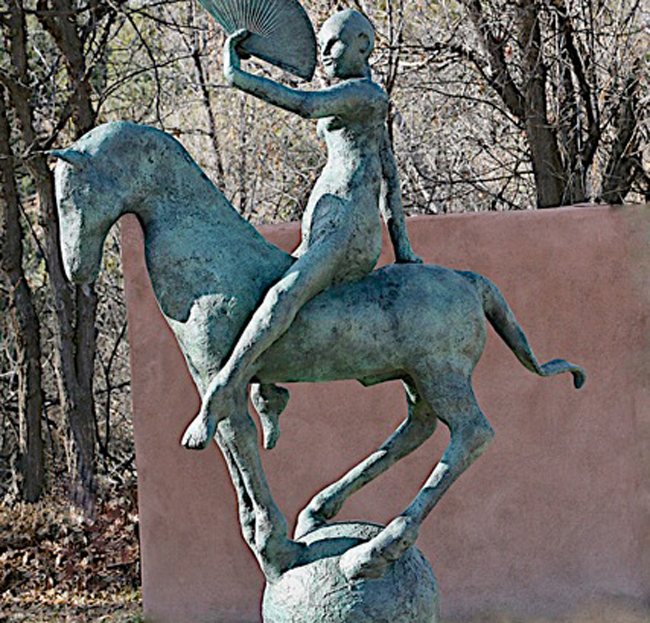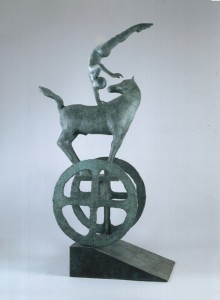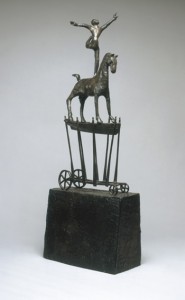
Thomas Ostenberg Sculpture
“The first thing that strikes one about Thomas Ostenberg’s sculptures is that they are so joyful… Ostenberg’s animals (usually but not always horses) and his human personages have an exuberance which immediately lifts the spectator’s own spirits.”
“Ostenberg’s sculpture is transformative – which is one reason why he uses a traditional material, cast bronze. He needs to take his ideas and fantasies and reshape them into what are, for him, absolutely definitive forms. The provisional nature of the supposedly ‘new’ art which has now displaced painting and sculpture in so many international survey exhibitions is not for him because they do not allow the transformation to complete itself as fully as he wants – or as he finds satisfying to him. Each of these sculptures represents a catharsis: something sensed, dreamed about, brooded over – and finally made.”
— Edward Lucie-Smith – LONDON, 1999
“ A search for equilibrium” exquisitely sums up our sensations when walking around Ostenberg’s works…”
“We are struck instantly… with the realization that Ostenberg’s “cast of characters”, of dancing, leaping, breathtakingly risk-taking figures, seeks to achieve the paradoxical, i.e. a representation of dynamic stasis.”
“The composer John Cage always maintained that “theater is everywhere” and it is the true role of the artist to make visible that “theatrum mundi.” Ostenberg, too, finds vivacious “theater” at every turn, especially when he uncovers, as he puts it, “moments of significant or radical change, brought about not by any modifications in material circumstances, but by a simple change in thought and the way circumstances are perceived.”
— Jan E. Adlmann Santa Fe, May 2004
Thomas Ostenberg was born in Nebraska, grew up on a ranch in Colorado and spent his teenage years between Colorado and Florida. He studied languages at Principia College then earned a MBA degree from Stanford University. He entered the international financial world where he became a Vice President of Citibank in Brazil and Spain. In 1986 he went freelance as an independent International Financial Consultant. 
At age 40, Ostenberg exchanged his successful financial career for art school. He earned a BFA from the Kansas City Art Institute followed by a MA from the Royal College of Art in London aided by a grant from the Henry Moore Foundation. Now a full time sculptor, he claims his biggest break was “discovering that I wanted to be an artist”. Ostenberg maintains this change was precipitated by “fifteen years of seeing great art on three continents”. In particular he cites a major Velazquez exhibition in Madrid and a visit to the Rodin Museum in Paris.
He works primarily in bronze. The power and durability of his finished pieces belie his approach to the medium, which is quite fluid and intuitive. “Sometimes I will have a bit of clay or wax in my hand, and, by playing with this lump, some image or other just begins to appear.” For his large scale works he will have a specific image in mind to represent an emotion he hopes to convey. Using his hands and later, clay tools, he defines the image. “I alternate between building up and carving back until I achieve a result I am satisfied with.”
Ostenberg’s sculptures explore the theme of motion and balance. His work reflects his personal search for emotional and spiritual equilibrium. For him, the work “touches on the moment of step-ping into the unknown and doing so willingly.”
Ostenberg’s sculpture has been called joyful and magical, words not often applied to contemporary art. The works contain human figures and/or frequently horses on a variety of ladders, wheels and spheres, performing acrobatics and balancing acts much like those associated with the circus. This is not to say that his sculptures are frivolous or trivial. On the contrary, what may at first appear only as a feat intended to entertain is, at a deeper level, a wonderous allegory full of hope, strength, stamina, determination. The titles of Ostenberg’s sculptures (Mind Over Matter, In Search of a Clearer Understanding) give a sense of positive action that results in personal and, therefore, public benefit, and an understanding of life as a gift rather than a predicament. The sculptures themselves depict feats of enormous physical control and extraordinary mental focus. To view them is to experience triumph over contemporary malaises such as nihilism and despondency, to receive a message of calm amidst chaos – and ultimately, to feel joy in the pursuit of knowledge and truth. 
He divides his time with his two sons between Santa Fe, New Mexico and London. He also retains strong ties with Brazil and France where they maintain homes.



